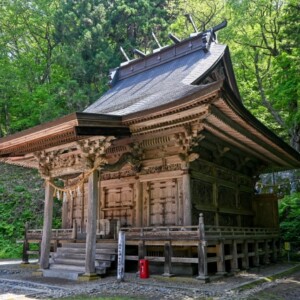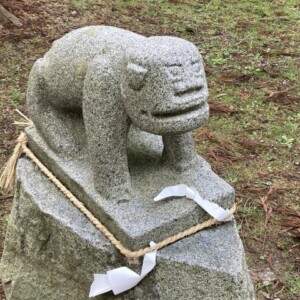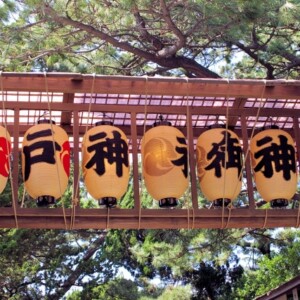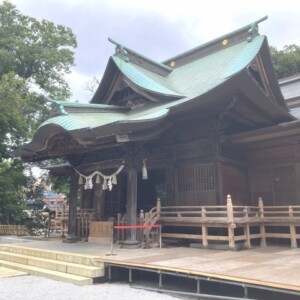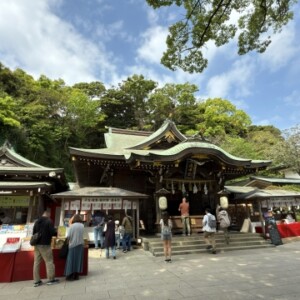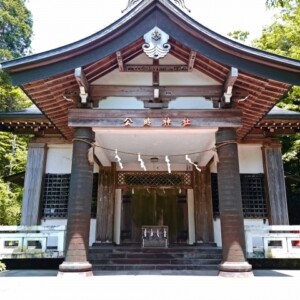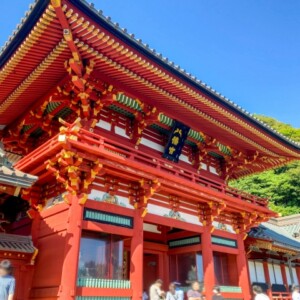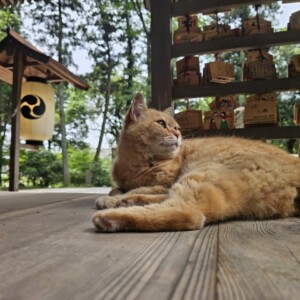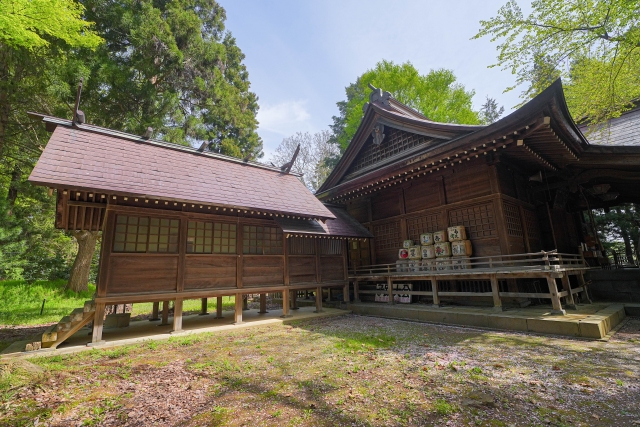
Saruga Shrine|Complete guide to the history, highlights, and worship information of this historic shrine
Saruga Shrine, located in Hirakawa City, Aomori Prefecture, is a historic shrine with a history of over 1,200 years. It is known throughout Japan as the “Sacred Land of Oshu Tsugaru,” especially for the northernmost lotus flowers that bloom in the summer. Deeply believed in by the local people as a guardian deity of agriculture, fishery, transportation, and eyesight, the shrine welcomes worshippers with its beautiful nature throughout the four seasons.
Outline and basic information about Saruga Shrine
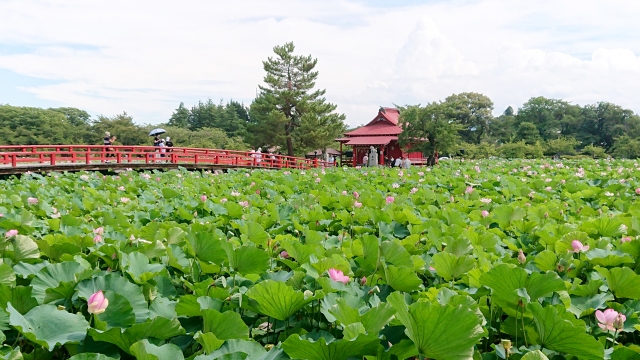
Saruga Shrine has a vast precincts of approximately 16,000 tsubo (approximately 1,000 square meters), which together with the adjacent Saruga Park form a beautiful landscape. Formerly a prefectural shrine, it is now designated as an attached shrine by the Jinja Honcho. The cherry blossoms in spring, lotus blossoms in summer, autumn leaves in fall, and snowy landscape in winter soothe visitors’ hearts throughout the year.
History and Origin
Saruga Shrine has a long history and was founded in 807 as Fukasagomiya (Shrine of the Divine Snake). It is said that the Seiin Taishogun (barbarian general) Sakagami Tamuramaro was deeply involved in the founding of the shrine.
The deity, Kaminokundamichi no Mikoto, was a military commander who is said to have been killed in battle at Ichiisuimon during the defeat of Emishi in the 55th year of Emperor Nintoku (367). Legend has it that he later took the form of a giant serpent and subdued the Yezo, and this mythological background explains the shrine’s spiritual nature.
In the Heian period (794-1185), the shrine was combined with Fukasuna Daioh, a Buddhist guardian deity, and came to be called Fukasuna Daigongen (Shrine of the Divine Snake). In the Edo period (1603-1867), the shrine became a place of prayer for the Tsugaru clan, and prospered as a place of ascetic practice under the name of “Sarugasan Chomei-in”.
With the separation of Shintoism and Buddhism during the Meiji era (1868-1912), the name was changed to the current “Saruga Shrine” in 1871, and in 1883 it was elevated to the status of prefectural shrine. After the war, the shrine became an annexed shrine of the Jinja Honcho in 1959, and has remained so to this day.
Deities and Benefits
The main deity of Saruga Shrine is Kamitsukenokimi-Tajinomikoto, and the deity Ukemochi-kami is enshrined in the second hall.
He is the fifth grandson of Emperor Sojin, and is known as a military commander who defeated the Emishi (barbarian tribes). He is widely worshipped as a god of war due to his valor, and is now widely believed to be a guardian deity for agriculture, fisheries, traffic safety, healing eye diseases, and people born in the year of the dragon and the year of the snake.
The deity of food preservation is known as the deity responsible for a good harvest, and is especially important in the Tsugaru region, where agriculture thrives. With the blessings of both deities, worshippers can pray for good fortune and protection from bad luck in various fields.
Saruga Shrine Highlights and Features
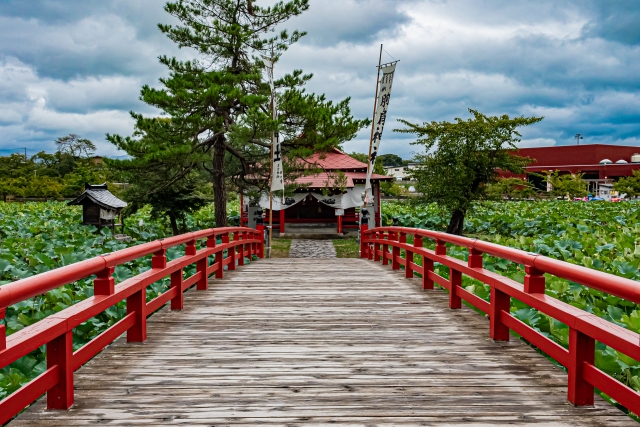
Saruga Shrine is known for its beautiful harmony of historical buildings and natural scenery. The shrine grounds are dotted with numerous sights, allowing visitors to enjoy both history and nature at the same time.
Architectural and Structural Attractions
The main shrine building is a Sangensha Nagare-zukuri style, rebuilt in 1826, and is designated as a treasure by Aomori Prefecture. The main hall is characterized by its 3-ken beam space (depth), as opposed to the 2-ken beam space (depth) of the standard Sangensha Nagare-zukuri style. Usually, a front room is added, but SARUGA-JINJA does not have a front room, and the entire beam space of the main building is 3 ken, making it an extremely valuable structure in terms of early modern shrine architecture in Aomori Prefecture.
The shrine grounds are designed with multiple torii gates, which increase one’s awareness of the sacred area as one proceeds along the approach to the shrine. In addition, stone lanterns and guardian dogs are placed throughout the shrine grounds to remind visitors of the long history of the shrine.
A variety of Kora-inu (guardian dogs) greet visitors at Saruga Shrine. One of the highlights of the shrine is a rare pair of Koryo dogs, a father and son guarding their offspring and sternly guarding against foreign enemies.
Kagamigaike Pond and lotus flowers at the northern limit
Kagamigaike Pond and Kagamigaike Pond, the center of the Saruga Shrine faith, are widely known as the northernmost lotus flower colony. This pond is symbolic of the shrine and one of the most impressive sites for visitors.
Lotus flowers gradually begin to bloom in early July, reaching their peak in early August. When in full bloom, the entire pond is covered with beautiful light red lotus flowers, a spectacular sight that is popularly known as “the lotus flowers of Sarukasama.
Since the lotus flowers bloom most beautifully in the early morning, morning visitation is recommended. During this time, there are relatively few visitors, and you can spend a luxurious time facing the lotus flowers in the quiet precincts of the temple.
On the middle island of Kagamigaike, the Breast Shoulder Shrine (Benten-gu Shrine) sits, providing a special space where visitors can pay their respects while admiring the lotus flowers. The experience of crossing the red bridge to visit the shrine has a unique atmosphere that cannot be experienced at other shrines.
Integrated view with Saruga Park
Saruga Shrine is integrated with the adjacent Saruga Park to form a beautiful landscape. Within the park is Mihariga-ike Pond, which attracts many cherry blossom viewers in the spring. Weeping cherry trees, someiyoshino cherry trees, and yaezakura cherry trees bloom in sequence, and visitors can enjoy the spectacular cherry blossoms surrounding the two ponds.
Visitors can take a boat ride on Mihariga-ike Pond and enjoy the cherry blossoms and seasonal scenery from the water. Feeding the carp is also a popular activity for families.
The park is also dotted with shrines within its precincts, such as Breast Shoulder Shrine, Ikegami Shrine, Hiyoshi Shrine, and Ebisu Shrine, making it possible to enjoy a shrine tour. These shrines are valuable testaments to the expansion of the SARUGA Shrine’s sphere of worship.
The area surrounding SARUGA Shrine also offers a sense of the history of the Tsugaru region, and nearby is Morimi-en, a nationally designated place of scenic beauty. Many tourists enjoy walking through the history of the area in conjunction with their visit to the shrine.
Visiting and Worship Information
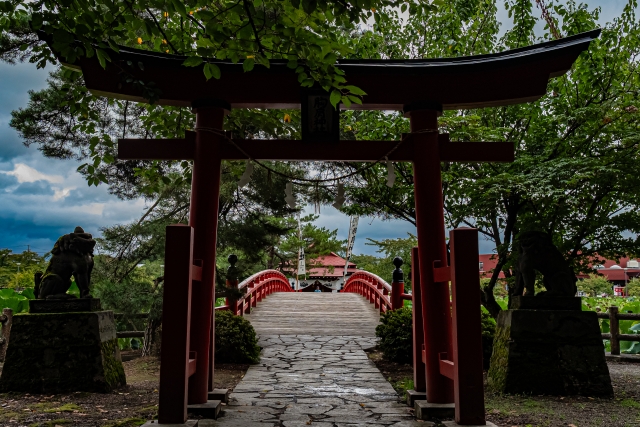
Saruga Shrine can be visited throughout the year, and each season offers its own beauty and sacred atmosphere. When visiting the shrine, please be mindful of proper manners and etiquette, and show respect for the sacred space.
Worship Etiquette and Manners
When worshipping at SARUGA Shrine, follow the general manners of shrine visitation. When passing through the torii gate, bow lightly and avoid the center of the path. At the hand- and mouth-cleansing booth, purify your body and mind by cleansing your left hand, right hand, and mouth, in that order, before proceeding to the hall of worship.
Once at the hall of worship, you should bow to the deity in the manner of “Ni-ni-no-happo-te-Ichi-wai” (two clapping hands and one bow). After offering money, bow deeply twice, clap twice at chest level, and finally bow deeply once. When praying, make your requests with all your heart and with gratitude.
The temple grounds are a sacred place, so please refrain from talking loudly or running around, and worship quietly. Photography is allowed, but please be considerate not to disturb other visitors and refrain from taking pictures in areas where photography is prohibited, such as inside the main shrine.
Annual and Seasonal Events
Many festivals are held throughout the year at Saruuga Shrine, especially the Nanoka-do Daisai Matsuri, which has been selected as a national intangible folk cultural asset as “Tsugaru no Nanoka-do Matsuri” (Tsugaru Nanoka-do Festival).
The Nanakkido Grand Festival, held on January 7 of the lunar calendar (around February today), is a traditional ritual that has continued since 1613, and includes the willow karami ritual and the sesame rice cake throwing ritual. Together with Iwakisan Shrine and Onigami Shrine in Hirosaki City, it is known as “Tsugaru’s Nanakkido Festival” and attracts many worshippers.
The largest festival in Tsugaru, the “Saruga Shrine Fifteen Nights Grand Festival,” is held from August 14 to 16 of the lunar calendar (the beginning of October today). The festival features the Tsugaru Kagura, a prefectural intangible folk cultural asset, as well as the prefectural lion dance competition and the dedication of the “Tozanbayashi” (a folk dance to climb a mountain) over a period of three days.
During the “Grand Festival of the Worship Council” held every year on May 3, a ritual of shooting demon masks is performed, in which a board with a demon’s face painted on it is smashed with a bow, arrow, and sword, in hopes of driving away evil spirits.
The “Otaue Matsuri” held in the rice paddy near the shrine is a traditional ritual to pray for a good harvest, and was started in 1932 and has been continued even during the war.
Red Seal and Good Luck Charm Information
Saruga Shrine offers red seals throughout the year, and the initial fee is the same as that of most shrines. Especially during the summer season (from July 1 to late September), a special lotus flower red seal featuring the lotus flowers of Kagamigaike Pond is awarded. The red seal for this limited period is 500 yen for the first earning, and the distribution period may vary depending on the blooming of lotus flowers.
A wide variety of good luck charms are also available, with the lotus flower motif of “lotus maskori” (first fee 800 yen) being particularly popular. A charm to protect children, which is derived from the parent and child lions, is also available, and is appreciated by families raising children.
The shrine offers a variety of amulets for various wishes, such as traffic safety, protection from bad luck, good fortune, and academic success, to meet the diverse needs of visitors. Red seals and amulets are available at the shrine office, but it is recommended to check in advance for detailed information on the hours of conferment.
Access and Usage Information
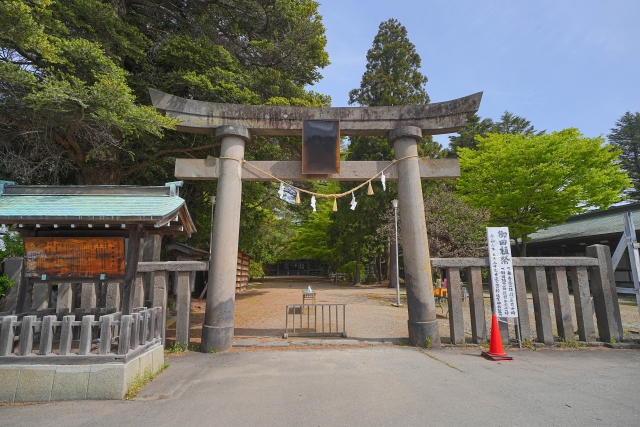
Saruga Shrine is located in Hirakawa City, Aomori Prefecture, and is accessible by both public transportation and private vehicles. A parking lot is available in the vicinity, making it a convenient tourist destination.
Transportation Access
By public transportation, transfer from Hirosaki Station on the JR Ou Main Line to the Konan Line of the Konan Railway and get off at Tsugaru-Ogami Station. It takes about 20 minutes from Hirosaki Station to Tsugaru-Ogami Station, and about 15 minutes on foot from Tsugaru-Ogami Station to Saruga Shrine.
By bus, take the “Hirosaki-Ogami Line” of the Konan Bus from JR Hirosaki Station or Tsugaru-Ogami Station of the Konan Railway, and get off at the “Saruga Shrine-mae” stop, which is very close to the shrine.
If coming by private car, the shrine is about 10 minutes away from the Kuroishi Interchange on the Tohoku Expressway. It takes about 1 hour from Aomori City and about 30 minutes from Hirosaki City.
If coming from Shin-Aomori Station, a convenient route is to take an express bus or JR from Shin-Aomori Station to Hirosaki Station and transfer to the Konan Railway at Hirosaki Station.
<Address> 175 Ishibayashi, Saruga, Hirakawa City, Aomori Prefecture, 036-0242
Hours of Admission, Fees and Parking Information
Saruga Shrine is open to visitors all day long, and there are no restrictions on visiting hours. However, the shrine office is generally open from 9:00 a.m. to 5:00 p.m. for the awarding of red seals and the purchase of amulets. Please contact the shrine (Tel: 0172-57-2016) in advance for detailed hours.
There is no fee to visit the shrine, and anyone is free to enter the shrine grounds. However, some restrictions may apply during special festivals and events, so it is recommended to check in advance.
Free parking for visitors is available in front of the shrine’s torii gate. Free parking is also available in the adjacent Saruga Park parking lot (capacity for approximately 200 vehicles). If you plan to visit with a large bus, please use the parking lot in Saruga Park.
During the lotus blossom season, cherry blossom season, and major festivals, the parking lot may become crowded due to the large number of visitors and tourists. We recommend that you visit the temple early, especially on weekends and holidays.
Please contact the shrine directly for details on barrier-free accessibility considerations. Guided tours are also available, and reservations can be made through the Hirakawa Tourist Association (Tel: 0172-40-2231). Reservations must be made at least 5 days prior to the desired guided tour date.
Reference site
Saruga Shrine official website: http://ss701927.stars.ne.jp/
Hirakawa City Tourism Association: https://hirakawa-kankou.com/2019/04/15/saruka-jinja/
Aomori Prefecture Tourism Information Site Amazing AOMORI: https://aomori-tourism.com/spot/detail_1884.html



